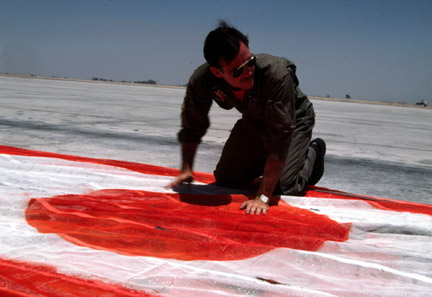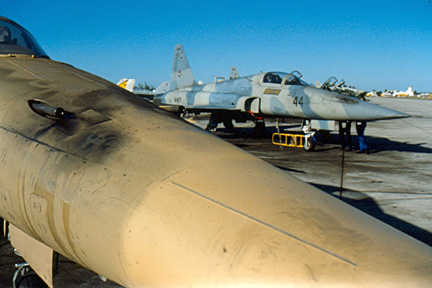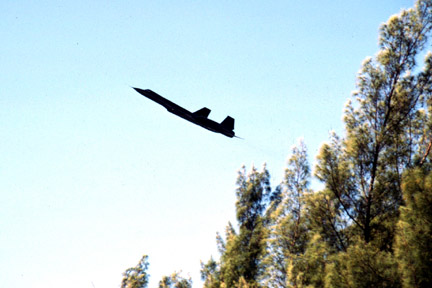SR-71 Encounter
Another vignette from my days as a Topgun instructor.
Naval Air Station (NAS) Key West, Florida -- April 1986.
Topgun was making another trip from our home base of NAS Miramar in San Diego to Key West, where we had fewer distractions, access to extensive overwater training ranges, great weather, and could work with the local adversary squadron, Attack Squadron 45 (VA-45). Most of us would be on this detachment, or "det" for one to two weeks. We would concentrate on two primary tasks: training the group of new Topgun instructors who had recently arrived and practicing air-to-air gunnery by shooting at a large banner towed by another aircraft. We would also fly with VA-45, and just maybe get out for some of the great food and drink to be found in Key West. Okay, there was no "maybe" about that last part, we always had a great time on these trips!
Flying with Topgun commanding officer "Dirty" Dan Shewell, I arrived in a two-seat F-5F on a Saturday afternoon. The advance party was set up and ready. They had told everyone flying over when to arrive, so several other instructors arrived in A-4s and F-5s about the same time we did. Advance party members drove rental cars out to the flight line to meet us. That would never happen at Miramar but seemed like a nice touch on a detachment. Something even further removed from normal Miramar operations was their offer of cold beer, just pulled from a cooler in the trunk of one of the cars.
Abnormal? Yes. But it was late afternoon, it was warm and breezy, we were done flying for the day, and we were on det to Key West. It was easy to rationalize.
Our amiable Maintenance Control Officer, Derf, walked up to a group of us and said with a grin, “Wait until you see what’s in the hangar.” His excitement was obvious, but he wouldn’t tell us any more than that. So we finished our beers and walked over to the hangar he indicated.
NAS Key West was no longer home to any Fleet squadrons, and its hangars were older than those I was used to at Miramar and Oceana. With peeling paint, flocks of birds in the rafters, and old fittings on their walls they seemed to be relics from World War II.
So when I walked into the hangar I was stunned to see the sleekest, blackest flying machine ever, the SR-71 Blackbird. An Air Force reconnaissance aircraft, at 107 feet long it was huge, even compared to the F-14 that I was familiar with. The smooth underside was roughly six feet above the ground, so I could look under its belly, or look up at its cockpit, engines, and tails. The machine seemed even more fantastic in the ancient dusty hangar, illuminated by the afternoon light that penetrated the yellow windows and gaps in the huge hangar doors.
Six Air Force security policemen in camouflaged uniforms guarded the jet, with M16 assault rifles held across their chests. I don’t know how long this shift had been on duty, but they looked alert and intent. I walked into the hangar with four or five other instructors. We started at the Blackbird’s nose, walked about ¾ along the length of the jet, and stopped near the left engine. We were all thrilled to get such a close-up look. Of course I had my camera in hand and ready.
“Sir, no photography is allowed, sir! Sir, I need to see your Armed Forces Identification card, sir.” He spoke clearly and authoritatively, using the “sir sandwich” form of sentence construction.
I outranked him, thus his frequent use of the word “sir.” But he had an M16 and was doing his job. As I reached for my wallet I looked him straight in the eye and calmly said, “Okay, got it. I haven’t taken any pictures. Here’s my ID.”
He shifted to a more normal voice but retained the bearing of a sentry. “Thank you, sir. We haven’t seen anyone else in here with a camera. If we see any photos of this jet in this hangar, we’re going to talk to you first.” He wrote down my name, ID number, and other information.
We learned that the jet was on a mission near Key West when it had trouble with its left engine. Indeed, we could see holes where pieces of the disintegrating engine had pierced the skin of the nacelle. The crew made an emergency landing at NAS Key West and taxied into this hangar. Navy security police stood guard until Air Force personnel arrived from the Miami area to take over. It had been in the hangar just a few hours at this point. Repair crews were on the way.
The SR-71 is a beautiful and fascinating aircraft, and we Topgun instructors soaked it in for a few more minutes. But then we returned to the business of the det. Off to change and hit the town, for dinner and a few beers.
It was a different Bio on the Key West det in 1986, compared to the new instructor who made the 1984 Key West det. Now I had been at Topgun a year and a half and was therefore one of the old guys. As a RIO, I was definitely a minority on the staff – around this time we had four or five RIOs out of 18 or 20 total instructors – but I had established and proven myself. I gave a tactics lecture and a FAST* lecture. I had become head of the FAST team. I was briefing, leading, and debriefing class flights as well as other training flights. I had learned much and taught much. I had lost arguments and won arguments. I had made mistakes and corrected mistakes. I knew my facts and mission, I knew the aircraft and weapons, I knew the material and the students.
For me it was a great Key West det.
In five days I flew six 1v1s training new instructors, plus a 4vUNK against some Fleet Tomcats in town to take advantage of the consistent great weather and operating areas near the field. I also flew one air-to-air gunnery flight. During the det shooting the banner was almost equal in priority to training new instructors, as a way of maintaining instructor skill and credibility.
 A pilot examines the target banner after it has been dropped on the airfield, following an air-to-air gunnery training mission.
A pilot examines the target banner after it has been dropped on the airfield, following an air-to-air gunnery training mission.
 Gun soot smudges the noses of Topgun F-5s on the flight line at NAS Key West at the end of a flying day.
Gun soot smudges the noses of Topgun F-5s on the flight line at NAS Key West at the end of a flying day.
We were busy and enjoying our normal instructor lives, but the movie again became an issue during the det. (The movie was the original "Top Gun." This story took place about a month before it was released.) First, Paramount invited all instructors to a preview at their theater in Hollywood and they needed to know who would attend. This would be the week after we got back from Key West. Second, they were having a “West Coast Benefit Premiere” in San Diego in mid-May, and advised us that tickets would be $50 per seat.
The Hollywood preview was easy, Rat collected names and sent them to Paramount.
As for arranging tickets for the premiere, you might say we were taken aback. It wasn’t even going to be the “world premiere.” And weren’t we Topgun instructors special? Most of us would be taking wives or dates, and $100 was a lot to see a movie, even if it was about us. Sort of. The resolution to this micro-quandary happened quickly, when Hughes Aircraft Company, manufacturers of the radars in the F-14 and F/A-18, offered to cover the cost of two tickets for each Topgun instructor. So Rat once again sent in a list of names.
The rest of the SR-71 story is a mix of goods and others. Neither the Air Force nor the Navy initially publicized the fact that it was at the base, but its presence wasn’t really classified, either. After just a few days it seemed like everyone in Key West knew about the black jet. I guess that’s the “coconut telegraph” that Jimmy Buffett sings about. The public affairs people arranged for the jet to be rolled out of the hangar for viewing on a Wednesday afternoon, four days after its arrival. We were allowed to take photographs, which I did. I heard that a school bus full of children came by for a close-up look. The public showing was a nice move by the Air Force.
 The SR-71 on the ramp at Key West for public viewing.
The SR-71 on the ramp at Key West for public viewing.
The jet took off Thursday morning. I was in a flight briefing that started at 10:00, but when the SR-71 taxied out to the runway we adjourned the brief and went outside. It was an airshow atmosphere as many people walked across the ramp to stand in grass near the runway. Looking as cool as any man-made object ever looked, the jet sat at the end of the runway while the pilot and back-seater performed takeoff checks. When those were complete the pilot advanced the throttles and lit the burners. The sound was deafening; the sight was exciting.
The jet was large but sleek, and its acceleration was brisk. Halfway down the runway the pilot pulled the nose up, but only climbed a thousand feet or so. He made a sharp left turn and flew toward downtown Key West a few miles away, disappearing behind the tree line. A moment later we could hear their approach. They flew over the field at low altitude, lighting the burners as they passed. The jet was a triple-sonic manta ray of flowing curved surfaces and elegant proportions, painted flat black. The crew made another circuit, and then over the base they lit the burners and pulled the nose up to climb out of sight.
 The Blackbird emerges from behind the treeline during one of its Key West fly-bys.
The Blackbird emerges from behind the treeline during one of its Key West fly-bys.
I walked back inside with the rest of my flight to finish the brief, preoccupied by the great display, but aware of the complex 4vUNK mission I would soon be flying. As the flight lead was finishing the brief and asking for spin procedures, we were distracted again, this time by the wailing sirens of the NAS Key West crash crew. Fire engines raced toward the main runway.
Moments later the same SR-71 eased in for a smooth landing, turned at the end of the runway, and taxied into the same hangar.
The SDO came in to our brief to announce the runway was closed. Shortly after takeoff the Blackbird crew determined they had damage to their other engine. Their home base was in California, but since they had a repair crew at Key West, they returned to the island.
Trucks combed the runway for engine debris and after 30 minutes it was open, so our 4vUNK mission went with just a brief delay.
I left Key West after a week of the det, flying back to Miramar on a Saturday so I could give a FAST course to two air wings the following week. Most of the other instructors also came home that weekend, but a few stayed through the following week.
Meanwhile back at the bar in the Key West officers' quarters, several Topgun instructors talked to the SR-71 pilots about their departure that Thursday morning. “Nice fly-by, but that climb-out.... Is that as good as it gets?” We had commented to each other how we thought it was kind of weak, and a few of our guys mentioned it to the Blackbird’s crew.
I was gone when the repaired Blackbird took off the second time. It didn’t do any fly-bys around the island this time, but the instructors who were there said the climb-out was impressive. Impressive – that’s a real compliment not often heard from a bunch of Topgun instructors.
PS In the bar, several of us asked the crew about the top speed of the SR-71. They didn't tell us.
Several other photos are posted in Gallery 3.
* FAST: Fleet Air Superiority Training, a one-week program run by Topgun to give fighter and E-2 Hawkeye aircrews specialized training in defending an aircraft carrier from a raid by bombers, cruise missiles, and jammers. The concept was to apply Topgun-level training to this challenging problem. FAST included lectures and complex scenarios in simulators.
Questions or comments? Contact: Bio@TopgunBio.com

